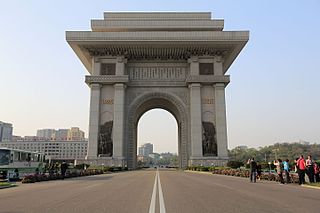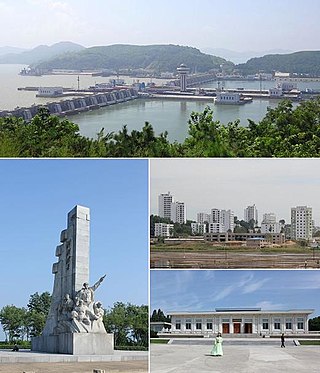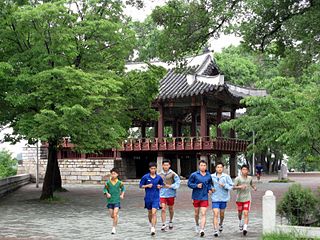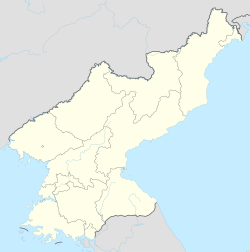
Pyongyang is the capital and largest city of the Democratic People's Republic of Korea (DPRK), commonly known as North Korea, where it is sometimes labeled as the "Capital of the Revolution". Pyongyang is located on the Taedong River about 109 km (68 mi) upstream from its mouth on the Yellow Sea. According to the 2008 population census, it has a population of 3,255,288. Pyongyang is a directly administered city with a status equal to that of the North Korean provinces.

Nampo, also spelled Namp'o, is a city in North Korea which is the country's fourth-largest by population. The city is an important seaport in the country as it lies on the northern shore of the Taedong River, 15 km east of the river's mouth. Formerly known as Chinnamp'o, it was a provincial-level "Directly Governed City" ("Chikhalsi") from 1980 to 2004, and was designated a "Special City" in 2010. Nampo is approximately 50 km southwest of Pyongyang, at the mouth of the Taedong River. Since North Korean independence, the city has developed a wide range of industry and has seen significant recent redevelopment.

Wonsan, previously known as Wonsanjin (元山津), is a port city and naval base located in Kangwon Province, North Korea, along the eastern side of the Korean Peninsula, on the Sea of Japan and the provincial capital. The port was opened by occupying Japanese forces in 1880. Before the 1950–1953 Korean War, it fell within the jurisdiction of the then South Hamgyong province, and during the war, it was the location of the Blockade of Wonsan. The population of the city was estimated at 329,207 in 2013. Notable people from Wonsan include Kim Ki-nam, a diplomat and former Vice Chairman of the ruling Workers' Party of Korea.

Rodong Sinmun is a North Korean newspaper that serves as the official newspaper of the Central Committee of the Workers' Party of Korea. It was first published on 1 November 1945, as Chŏngro, serving as a communication channel for the North Korea Bureau of the Communist Party of Korea. It was renamed in September 1946 to its current name upon the steady development of the Workers' Party of Korea. Quoted frequently by the Korean Central News Agency (KCNA) and international media, it is regarded as a source of official North Korean viewpoints on many issues.

Pyongsong is a city in North Korea, the capital city of South Pyongan province in western North Korea. The city is located about 32 kilometres northeast of Pyongyang, and was formally established in December 1969. It has a population of 284,386.

Pyongyang Tram is a public tram system in Pyongyang, the capital of the North Korea. The first line of the current system opened in 1989. There are currently four lines in operation.

P'yŏngch'ŏn-guyŏk is one of the 18 guyŏk of Pyongyang, North Korea. It is bordered by the Taedong River in the south and the Pothonggang Canal in the north and Potong River in the west, and to the east by Chung-guyŏk, from which it is separated by the yard area of Pyongyang railway station.

Potonggang-guyok is one of the 18 districts, or guyok, of Pyongyang, North Korea. It is most famous as the location of the Ryugyong Hotel. It is named after the Pothong River, which serves as the district's border on all sides. It is bordered to the north by Hyongjesan-guyok, to the east by Sosong and Moranbong-guyoks, to the south by Pyongchon and Chung-guyoks, and to the west by Mangyongdae-guyok. The district was established by the Pyongyang City People's Committee in October 1960.

Moranbong-guyŏk (Korean: 모란봉구역), or the Moranbong District, is one of the 18 guyŏk which constitute the capital city of Pyongyang, North Korea. It is located north of Chung-guyok, the city's central district, and is bordered to the north by Sosong and Taesong-guyoks, to the east by the Taedong River, and the west by the Pothonggang Canal and Potonggang-guyok. It is named after Moran Hill, located in the district's west area – Moran. It was designated a guyŏk in October 1960 by the Pyongyang City People's Committee.

Tongdaewŏn-guyŏk or Tongdaewon District is one of the 18 wards, and one of the six that constitute East Pyongyang, North Korea. It sits on the eastern bank of the Taedong River. It is north of Sŏn'gyo-guyŏk, south of Taedonggang-guyŏk and west of Sadong-guyŏk and Ryŏkp'o-guyŏk. It was established in October 1960.

Taedonggang-guyŏk, or Taedong River District, is one of the 18 guyŏk, and one of the six that constitute East Pyongyang, North Korea. Taedonggang-guyŏk is on the eastern bank of the Taedong River, north of Tongdaewŏn-guyŏk and west of Sadong-guyŏk. It was established in January 1958.

Sadong-guyŏk, or Sadong District, is one of the 18 guyŏk, and one of the six, that constitute East Pyongyang, North Korea. It is on the eastern bank of the Taedong River, and the mouth of the Nam River. It is north of Ryŏkp'o-guyŏk, east of Taedonggang-guyŏk and north east of Tongdaewŏn-guyŏk. It was established in September 1959.

Kim Il Sung Square is a large city square in the Central District of Pyongyang, North Korea, and is named after the country's founding leader, Kim Il Sung. The square was constructed in 1954 according to a master plan for reconstructing the capital after the destruction of the Korean War. It was opened in August 1954. The square is located on the foot of the Namsan Hill, west bank of the Taedong River, directly opposite the Juche Tower on the other side of the river. It is the 37th largest square in the world, having an area of about 75,000 square metres which can accommodate a rally of more than 100,000 people. The square has a great cultural significance, as it is a common gathering place for concerts, rallies, dances and military parades and is often featured in media concerning North Korea.

Rangrang-guyŏk or Rangrang District is one of the 18 kuyŏk that constitute the city of Pyongyang, North Korea. It is located south of the Taedong River, and is bordered to the north by Songyo-guyok, to the east by the Ryokpo-guyok, and to the south by Chunghwa and Kangnam counties.

Ryongwang Pavilion is a scenic overlook located in the central district of Pyongyang, North Korea. Located on the bank of the Taedong River, the pavilion was first constructed during the Goguryeo dynasty as "Sansu Pavilion", and was part of the defenses of the walled city of Pyongyang. It is labeled as National Treasure #16 in North Korea.

Pyongyang station is the central railway station of P'yŏngyang, North Korea. It is located in Yŏkchŏn-dong, Chung-guyŏk.

Ongryu Bridge, also spelled Okryu Bridge and Ongnyu Bridge, is a bridge on the Taedong River in and near Pyongyang, North Korea. Construction began in March 1958; the bridge was opened in August 1960.

The Pyongyang trolleybus system forms part of the public transport network of Pyongyang, the capital city of North Korea, and extends to some of its suburbs.

The COVID-19 pandemic in North Korea was part of a global pandemic of coronavirus disease 2019 (COVID-19), a novel infectious disease caused by severe acute respiratory syndrome coronavirus 2 (SARS-CoV-2). North Korea confirmed its first case on 8 May 2022.























